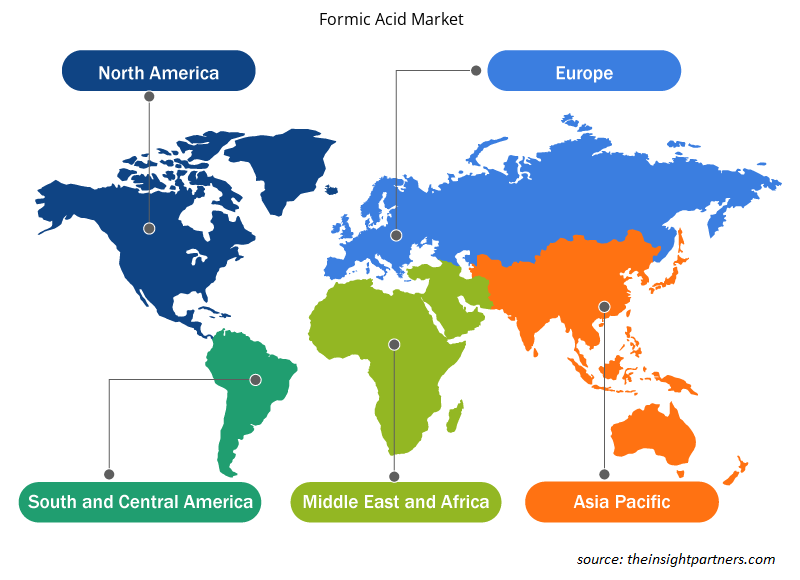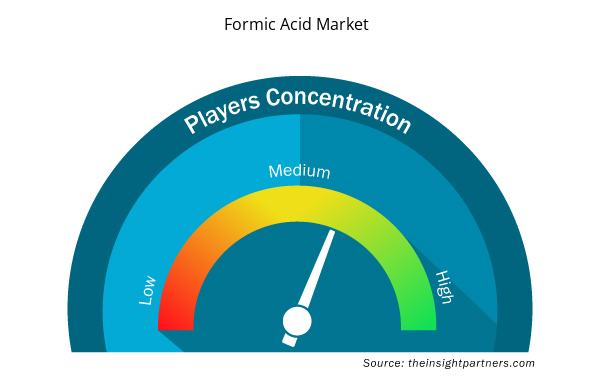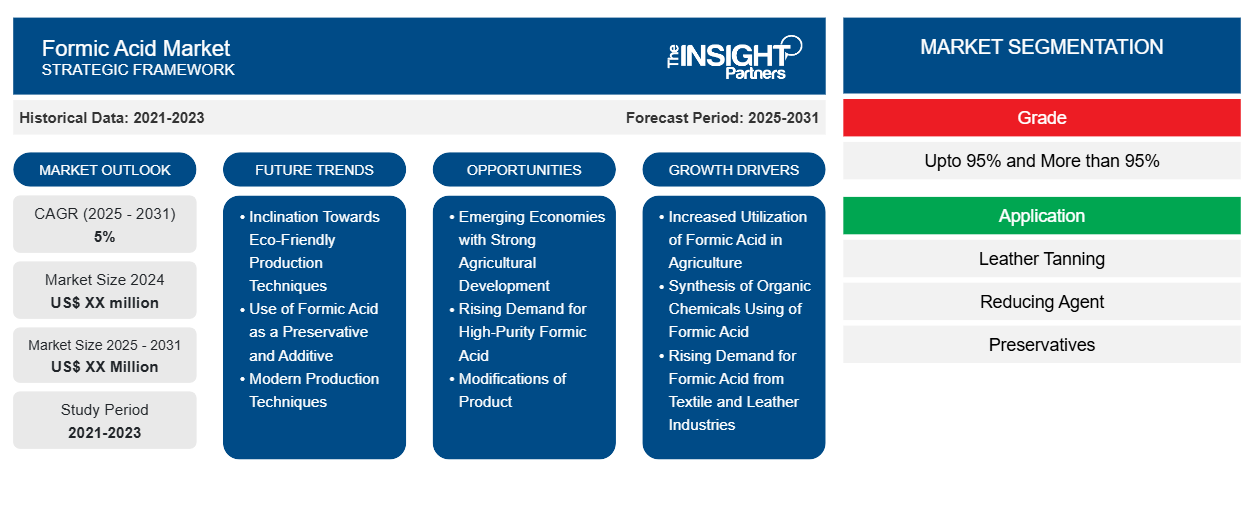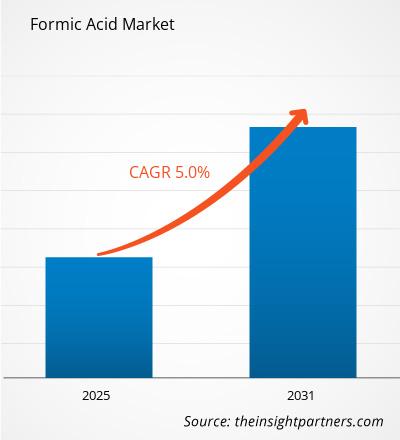من المتوقع أن يسجل سوق حمض الفورميك معدل نمو سنوي مركب بنسبة 5٪ من عام 2024 إلى عام 2031، مع توسع حجم السوق من XX مليون دولار أمريكي في عام 2024 إلى XX مليون دولار أمريكي بحلول عام 2031.
تم تقسيم التقرير حسب الدرجة (حتى 95٪ وأكثر من 95٪). يقدم التقرير أيضًا تحليلًا يعتمد على التطبيق (دباغة الجلود، عامل الاختزال، المواد الحافظة، سوائل الحفر، المواد الوسيطة وغيرها) وصناعة الاستخدام النهائي (المنسوجات، المطاط، المواد الكيميائية، معالجة الأغذية، النفط والغاز، الزراعة وغيرها). يتم تقسيم التحليل العالمي بشكل أكبر على المستوى الإقليمي والدول الرئيسية. يغطي النطاق حجم السوق والتوقعات على المستويات العالمية والإقليمية والقطرية لجميع قطاعات السوق الرئيسية. يقدم التقرير القيمة بالدولار الأمريكي للتحليل والقطاعات المذكورة أعلاه. يقدم التقرير إحصائيات رئيسية عن حالة السوق للاعبين الرئيسيين في السوق ويعرض اتجاهات السوق والفرص.
غرض التقرير
يهدف تقرير سوق حمض الفورميك الصادر عن The Insight Partners إلى وصف المشهد الحالي والنمو المستقبلي وأهم العوامل الدافعة والتحديات والفرص. سيوفر هذا رؤى لمختلف أصحاب المصلحة في الأعمال التجارية، مثل:
- مزودي/مصنعي التكنولوجيا: لفهم ديناميكيات السوق المتطورة ومعرفة فرص النمو المحتملة، وتمكينهم من اتخاذ قرارات استراتيجية مستنيرة.
- المستثمرون: إجراء تحليل شامل للاتجاهات فيما يتعلق بمعدل نمو السوق، وتوقعات السوق المالية، والفرص المتاحة عبر سلسلة القيمة.
- الهيئات التنظيمية: لتنظيم السياسات ومراقبة الأنشطة في السوق بهدف تقليل الانتهاكات والحفاظ على ثقة المستثمرين والحفاظ على سلامة السوق واستقرارها.
تجزئة سوق حمض الفورميك
درجة
- تصل إلى 95% وأكثر من 95%
طلب
- دباغة الجلود
- عامل الاختزال
- المواد الحافظة
- سوائل الحفر
- الوسيطات وغيرها
صناعة الاستخدام النهائي
- المنسوجات
- ممحاة
- كيميائي
- معالجة الأغذية
- النفط والغاز
- الزراعة وغيرها
الجغرافيا
- أمريكا الشمالية
- أوروبا
- آسيا والمحيط الهادئ
- أمريكا الجنوبية والوسطى
- الشرق الأوسط وأفريقيا
قم بتخصيص هذا التقرير ليناسب متطلباتك
ستحصل على تخصيص لأي تقرير - مجانًا - بما في ذلك أجزاء من هذا التقرير، أو تحليل على مستوى الدولة، وحزمة بيانات Excel، بالإضافة إلى الاستفادة من العروض والخصومات الرائعة للشركات الناشئة والجامعات
- احصل على أهم اتجاهات السوق الرئيسية لهذا التقرير.ستتضمن هذه العينة المجانية تحليلاً للبيانات، بدءًا من اتجاهات السوق وحتى التقديرات والتوقعات.
عوامل نمو سوق حمض الفورميك
- الاستخدام المتزايد لحمض الفورميك في الزراعة: يعد الاستخدام المتزايد لحمض الفورميك في الزراعة، وخاصةً كمواد حافظة للسيلاج والأعلاف الحيوانية، أحد أهم العوامل التي تغذي نمو سوق حمض الفورميك. كما يساعد في تحسين القيمة الغذائية للأعلاف من خلال تقليل التلف، وهو جانب بالغ الأهمية لصحة الحيوان وإنتاجيته. إن الزيادة في استهلاك اللحوم ومنتجات الألبان في جميع أنحاء العالم تعمل على زيادة الطلب على إضافات الأعلاف الفعالة، وبالتالي سوق حمض الفورميك.
- تخليق المواد الكيميائية العضوية باستخدام حمض الفورميك: يتضمن تخليق مواد كيميائية أخرى مثل الميثانول وحمض الأسيتيك والمواد الكيميائية العضوية المختلفة استخدام حمض الفورميك. هناك حاجة إلى خصائصه الكيميائية التي تسمح باستخدامه كعامل اختزال أو محفز في عمليات التصنيع الكيميائي. كما أن نمو أنشطة التصنيع الكيميائي بسبب المستوى المتزايد للتصنيع والاستهلاك المتزايد للمواد الكيميائية المتخصصة، يساعد أيضًا في نمو سوق حمض الفورميك.
- الطلب المتزايد على حمض الفورميك من صناعات النسيج والجلود: تعد صناعات النسيج والجلود أيضًا من كبار المستهلكين لحامض الفورميك لأنه عامل أساسي في عمليات الصباغة والتشطيب والدباغة. ومن المتوقع أن يؤدي ارتفاع استهلاك المنسوجات والجلود الموجهة نحو الجودة إلى جانب الزيادة في قطاع الأزياء إلى زيادة مبيعات حمض الفورميك. ونظرًا لأن الشركات المصنعة ترغب في تحسين جودة وقوة السلع المتاحة، فمن المرجح أيضًا أن يزداد الطلب على حمض الفورميك في هذه الصناعات.
الاتجاهات المستقبلية لسوق حمض الفورميك
- الميل نحو تقنيات الإنتاج الصديقة للبيئة: هناك ميل متزايد نحو تقنيات الإنتاج الصديقة للبيئة في سوق حمض الفورميك. وفي هذا الصدد، يطبق المصنعون بشكل متكرر مبادئ الكيمياء الخضراء لتقليل آثارهم الضارة على البيئة. ويشمل ذلك تثمين نفايات العمليات لإنتاج حمض الفورميك الحيوي من المحاصيل غير الغذائية والنفايات الزراعية مع أهداف الاستدامة العالمية وكوسيلة للقضاء على الاعتماد على الوقود الأحفوري.
- استخدام حمض الفورميك كمادة حافظة ومادة مضافة: إن التطورات الحديثة في تطبيقات التكنولوجيا تجعل استخدام حمض الفورميك في مختلف القطاعات أكثر فعالية. على سبيل المثال، يتم إجراء تطبيقات أفضل للمساعدة في استخدام حمض الفورميك كمادة حافظة ومادة مضافة. وعلاوة على ذلك، تعمل هذه الابتكارات على تحسين أداء المنتجات وتقليل النفقات التي يتكبدها المصنعون.
- تقنيات الإنتاج الحديثة: لقد أدى إدخال الإنتاج من خلال استخدام التقنيات الرقمية والأتمتة إلى تغيير صناعة حمض الفورميك بسرعة. أصبحت التصنيع أكثر ذكاءً، مع دمج المزيد من عمليات التصنيع والمواد والمنتجات بتقنيات مثل مراقبة عملية الإنتاج وتحليل البيانات. ومن المتوقع أن يؤدي هذا أيضًا إلى تحسين كفاءة عملية الإنتاج مع تقليل التكاليف المرتبطة بالهدر.
فرص سوق حمض الفورميك
- الاقتصادات الناشئة ذات التنمية الزراعية القوية: توفر الاقتصادات الناشئة حيث التصنيع والتنمية الزراعية على منحنى النمو إمكانات عالية للنمو في سوق حمض الفورميك. قد تتطلع الشركات إلى الدخول في تحالفات استراتيجية وعمليات اندماج واستحواذ لاختراق المناطق بسبب الاستخدام المتزايد لحمض الفورميك في الصناعات الزراعية والنسيجية والكيميائية في هذه المناطق.
- الطلب المتزايد على حمض الفورميك عالي النقاء: يزداد الطلب على حمض الفورميك عالي النقاء لتطبيقات محددة مثل الأدوية والإلكترونيات وغيرها. وبناءً على ذلك، يمكن للمنتجين الشروع في إنتاج حمض الفورميك عالي النقاء بهدف سد هذه الفجوات الموجودة في السوق. يمكن للمبادرات الاستراتيجية مثل هذه أن تقدم سبلًا جديدة في توليد الإيرادات وكذلك في اكتساب ميزة تنافسية.
- تعديلات المنتج: هناك إمكانيات في شكل فجوات في السوق لتعديل المنتجات بما يتماشى مع تركيبات المنتج التي تهدف إلى الابتكار، وخاصة حيث توجد حاجة لاستبدال المنتج المعتاد بمنتجات أكثر خضرة وأمانًا. وبالتالي، من خلال بعض الجهود في شكل تمويل إضافي موجه لتطوير منتجات جديدة، سيكون من الممكن للشركات التوصل إلى أنواع جديدة من المنتجات التي لن تتوافق فقط مع المتطلبات التنظيمية بل ستلبي أيضًا متطلبات السوق فيما يتعلق بالمنتجات الصديقة للبيئة. تركز نظرية الابتكار هذه على توسيع سوق المنتج الذي يتم إجراء مثل هذه التغييرات عليه، وخاصة في حالة حمض الفورميك الذي يمكن استخدامه في العديد من التطبيقات الجديدة.
رؤى إقليمية حول سوق حمض الفورميك
لقد قام المحللون في Insight Partners بشرح الاتجاهات والعوامل الإقليمية المؤثرة على سوق حمض الفورميك طوال فترة التوقعات بشكل شامل. يناقش هذا القسم أيضًا قطاعات سوق حمض الفورميك والجغرافيا في جميع أنحاء أمريكا الشمالية وأوروبا ومنطقة آسيا والمحيط الهادئ والشرق الأوسط وأفريقيا وأمريكا الجنوبية والوسطى.

- احصل على البيانات الإقليمية المحددة لسوق حمض الفورميك
نطاق تقرير سوق حمض الفورميك
| سمة التقرير | تفاصيل |
|---|---|
| حجم السوق في عام 2024 | XX مليون دولار أمريكي |
| حجم السوق بحلول عام 2031 | XX مليون دولار أمريكي |
| معدل النمو السنوي المركب العالمي (2025 - 2031) | 5% |
| البيانات التاريخية | 2021-2023 |
| فترة التنبؤ | 2025-2031 |
| القطاعات المغطاة | حسب الدرجة
|
| المناطق والدول المغطاة | أمريكا الشمالية
|
| قادة السوق وملفات تعريف الشركات الرئيسية |
|
كثافة اللاعبين في سوق حمض الفورميك: فهم تأثيرها على ديناميكيات الأعمال
يشهد سوق حمض الفورميك نموًا سريعًا، مدفوعًا بالطلب المتزايد من المستخدم النهائي بسبب عوامل مثل تفضيلات المستهلكين المتطورة والتقدم التكنولوجي والوعي المتزايد بفوائد المنتج. ومع ارتفاع الطلب، تعمل الشركات على توسيع عروضها والابتكار لتلبية احتياجات المستهلكين والاستفادة من الاتجاهات الناشئة، مما يؤدي إلى زيادة نمو السوق.
تشير كثافة اللاعبين في السوق إلى توزيع الشركات أو المؤسسات العاملة في سوق أو صناعة معينة. وهي تشير إلى عدد المنافسين (اللاعبين في السوق) الموجودين في مساحة سوق معينة نسبة إلى حجمها أو قيمتها السوقية الإجمالية.
الشركات الرئيسية العاملة في سوق حمض الفورميك هي:
- ألفا ايسار (ثيرمو فيشر ساينتيفيك)
- شركة انهوي اساهيكاسي الكيميائية المحدودة
- باسف اس اي
- شركة ايستمان للكيماويات
- شركة فيتشنغ للمواد الكيميائية الحمضية
- شركة جوجارات نارمادا فالي للأسمدة والمواد الكيميائية المحدودة
إخلاء المسؤولية : الشركات المذكورة أعلاه ليست مرتبة بأي ترتيب معين.

- احصل على نظرة عامة على أهم اللاعبين الرئيسيين في سوق حمض الفورميك
نقاط البيع الرئيسية
- التغطية الشاملة: يغطي التقرير بشكل شامل تحليل المنتجات والخدمات والأنواع والمستخدمين النهائيين لسوق حمض الفورميك، مما يوفر صورة شاملة.
- تحليل الخبراء: تم تجميع التقرير على أساس الفهم العميق لخبراء الصناعة والمحللين.
- معلومات محدثة: يضمن التقرير أهمية الأعمال التجارية بسبب تغطيته للمعلومات الحديثة واتجاهات البيانات.
- خيارات التخصيص: يمكن تخصيص هذا التقرير لتلبية متطلبات العملاء المحددة وبما يتناسب مع استراتيجيات العمل بشكل مناسب.
وبالتالي، يمكن أن يساعد تقرير البحث حول سوق حمض الفورميك في تمهيد الطريق لفك شفرة وفهم سيناريو الصناعة وآفاق النمو. ورغم وجود بعض المخاوف المشروعة، فإن الفوائد الإجمالية لهذا التقرير تميل إلى التفوق على العيوب.
- التحليل التاريخي (سنتان)، السنة الأساسية، التوقعات (7 سنوات) مع معدل النمو السنوي المركب
- تحليل PEST و SWOT
- حجم السوق والقيمة / الحجم - عالميًا وإقليميًا وقطريًا
- الصناعة والمنافسة
- مجموعة بيانات Excel

Report Coverage
Revenue forecast, Company Analysis, Industry landscape, Growth factors, and Trends

Segment Covered
This text is related
to segments covered.

Regional Scope
North America, Europe, Asia Pacific, Middle East & Africa, South & Central America

Country Scope
This text is related
to country scope.
الأسئلة الشائعة
Based on geography, Asia Pacific held the significant share of the formic acid market due to growth in the chemical and agriculture sector
Innovations in application technologies is expected to be the key market trends
Based on grade, more than 95% segment is expected to witness the fastest growth during the forecast period
Growth in the agriculture and animal feed sector is driving the market growth
BASF SE; Perstorp Holding AB; Eastman Chemical Company; HELM AG; LUXI GROUP are some of the key players operating in the formic acid market
The Formic Acid Market is estimated to witness a CAGR of 5% from 2023 to 2031
Trends and growth analysis reports related to Chemicals and Materials : READ MORE..
The List of Companies
1. Alfa Aesar (Thermo Fisher Scientific)
2. Anhui Asahikasei Chemical Co.
3. BASF SE
4. Eastman Chemical Company
5. Feicheng Acid Chemicals Co.,
6. Gujarat Narmada Valley Fertilizers & Chemicals Limited
7. HELM AG
8. LUMITOS AG
9. Luxi Chemical Group Co., Ltd.
10. Perstorp
The Insight Partners performs research in 4 major stages: Data Collection & Secondary Research, Primary Research, Data Analysis and Data Triangulation & Final Review.
- Data Collection and Secondary Research:
As a market research and consulting firm operating from a decade, we have published and advised several client across the globe. First step for any study will start with an assessment of currently available data and insights from existing reports. Further, historical and current market information is collected from Investor Presentations, Annual Reports, SEC Filings, etc., and other information related to company’s performance and market positioning are gathered from Paid Databases (Factiva, Hoovers, and Reuters) and various other publications available in public domain.
Several associations trade associates, technical forums, institutes, societies and organization are accessed to gain technical as well as market related insights through their publications such as research papers, blogs and press releases related to the studies are referred to get cues about the market. Further, white papers, journals, magazines, and other news articles published in last 3 years are scrutinized and analyzed to understand the current market trends.
- Primary Research:
The primarily interview analysis comprise of data obtained from industry participants interview and answers to survey questions gathered by in-house primary team.
For primary research, interviews are conducted with industry experts/CEOs/Marketing Managers/VPs/Subject Matter Experts from both demand and supply side to get a 360-degree view of the market. The primary team conducts several interviews based on the complexity of the markets to understand the various market trends and dynamics which makes research more credible and precise.
A typical research interview fulfils the following functions:
- Provides first-hand information on the market size, market trends, growth trends, competitive landscape, and outlook
- Validates and strengthens in-house secondary research findings
- Develops the analysis team’s expertise and market understanding
Primary research involves email interactions and telephone interviews for each market, category, segment, and sub-segment across geographies. The participants who typically take part in such a process include, but are not limited to:
- Industry participants: VPs, business development managers, market intelligence managers and national sales managers
- Outside experts: Valuation experts, research analysts and key opinion leaders specializing in the electronics and semiconductor industry.
Below is the breakup of our primary respondents by company, designation, and region:

Once we receive the confirmation from primary research sources or primary respondents, we finalize the base year market estimation and forecast the data as per the macroeconomic and microeconomic factors assessed during data collection.
- Data Analysis:
Once data is validated through both secondary as well as primary respondents, we finalize the market estimations by hypothesis formulation and factor analysis at regional and country level.
- Macro-Economic Factor Analysis:
We analyse macroeconomic indicators such the gross domestic product (GDP), increase in the demand for goods and services across industries, technological advancement, regional economic growth, governmental policies, the influence of COVID-19, PEST analysis, and other aspects. This analysis aids in setting benchmarks for various nations/regions and approximating market splits. Additionally, the general trend of the aforementioned components aid in determining the market's development possibilities.
- Country Level Data:
Various factors that are especially aligned to the country are taken into account to determine the market size for a certain area and country, including the presence of vendors, such as headquarters and offices, the country's GDP, demand patterns, and industry growth. To comprehend the market dynamics for the nation, a number of growth variables, inhibitors, application areas, and current market trends are researched. The aforementioned elements aid in determining the country's overall market's growth potential.
- Company Profile:
The “Table of Contents” is formulated by listing and analyzing more than 25 - 30 companies operating in the market ecosystem across geographies. However, we profile only 10 companies as a standard practice in our syndicate reports. These 10 companies comprise leading, emerging, and regional players. Nonetheless, our analysis is not restricted to the 10 listed companies, we also analyze other companies present in the market to develop a holistic view and understand the prevailing trends. The “Company Profiles” section in the report covers key facts, business description, products & services, financial information, SWOT analysis, and key developments. The financial information presented is extracted from the annual reports and official documents of the publicly listed companies. Upon collecting the information for the sections of respective companies, we verify them via various primary sources and then compile the data in respective company profiles. The company level information helps us in deriving the base number as well as in forecasting the market size.
- Developing Base Number:
Aggregation of sales statistics (2020-2022) and macro-economic factor, and other secondary and primary research insights are utilized to arrive at base number and related market shares for 2022. The data gaps are identified in this step and relevant market data is analyzed, collected from paid primary interviews or databases. On finalizing the base year market size, forecasts are developed on the basis of macro-economic, industry and market growth factors and company level analysis.
- Data Triangulation and Final Review:
The market findings and base year market size calculations are validated from supply as well as demand side. Demand side validations are based on macro-economic factor analysis and benchmarks for respective regions and countries. In case of supply side validations, revenues of major companies are estimated (in case not available) based on industry benchmark, approximate number of employees, product portfolio, and primary interviews revenues are gathered. Further revenue from target product/service segment is assessed to avoid overshooting of market statistics. In case of heavy deviations between supply and demand side values, all thes steps are repeated to achieve synchronization.
We follow an iterative model, wherein we share our research findings with Subject Matter Experts (SME’s) and Key Opinion Leaders (KOLs) until consensus view of the market is not formulated – this model negates any drastic deviation in the opinions of experts. Only validated and universally acceptable research findings are quoted in our reports.
We have important check points that we use to validate our research findings – which we call – data triangulation, where we validate the information, we generate from secondary sources with primary interviews and then we re-validate with our internal data bases and Subject matter experts. This comprehensive model enables us to deliver high quality, reliable data in shortest possible time.




 Get Free Sample For
Get Free Sample For